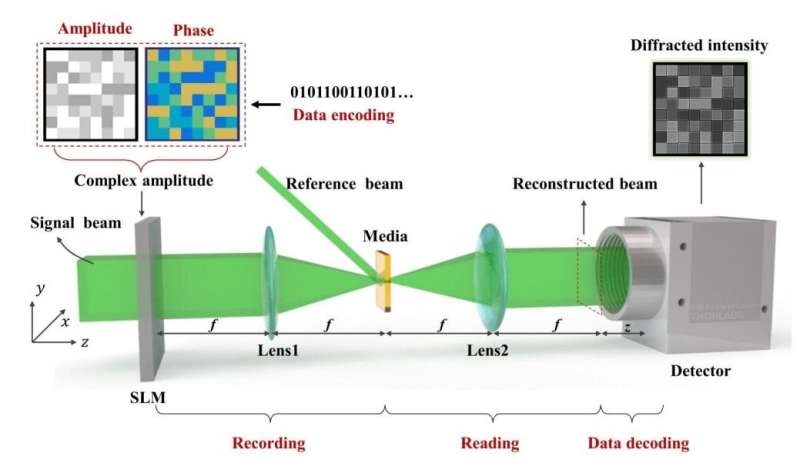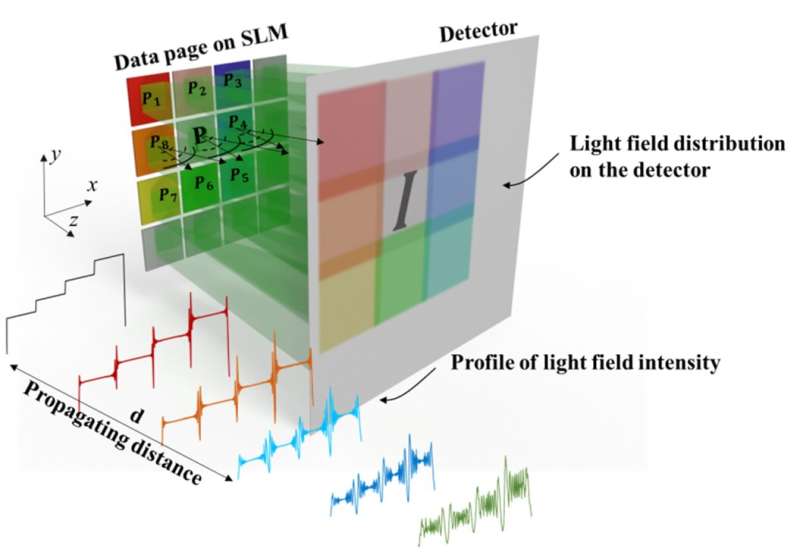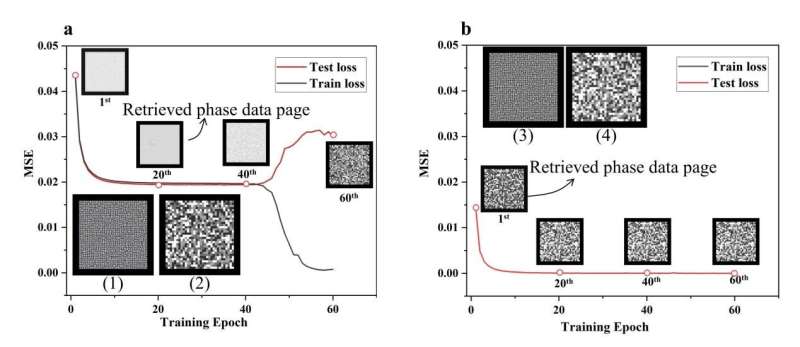This article has been reviewed according to Science X's editorial process and policies. Editors have highlighted the following attributes while ensuring the content's credibility:
fact-checked
proofread
Lensless complex amplitude demodulation based on deep learning in holographic data storage

In the era of big data, global data volume is growing exponentially. The development of numerous technologies depends on massive data and also generates massive data. Data mining, storage, and protection are becoming increasingly important. The development of traditional data storage technology can no longer keep up with the speed of data generation, and new high-density, long-lasting, and low-cost storage methods need to be developed.
Traditional data storage technology basically stores one-dimensional data on a two-dimensional surface. To break through the limitations of existing technologies, we need to think from storage dimension increasing.
Holographic data storage seems to be a feasible solution. It uses interference between information light encoding patterns and reference light encoding patterns to record holograms in the medium. When reading, only the reference beam is used to diffract the information light pattern from the hologram.
Holographic data storage technology has the characteristics of three-dimensional volume storage and two-dimensional data transmission, which enables higher storage density and faster data transmission speed, making it a powerful competitor for the next generation of storage technology.
In fact, holographic data storage technology has been proposed for 60 years, but it has not yet been practically applied. One of the reasons is that traditional holographic data storage uses only amplitude modulation, which does not correspond to the theoretical intention of holography, and the actual storage density achieved is far from the theoretical value.
To fully exploit the advantages of holographic data storage, complex amplitude modulation must be used for recording and reading. However, the technical bottleneck lies in phase reading, as the phase cannot be directly obtained by detectors.

The problem with using interference to read the phase is that the system is unstable and not conducive to practicality, while traditional non-interference methods often require iterative calculations, which reduce data transmission speed. In a new article in Opto-Electronic Advances, researchers propose to use the intensity image of near-field diffraction to simultaneously and non-iteratively read amplitude and phase information accurately without interference, solving the key technical bottleneck of holographic data storage complex amplitude modulation.
The core of this model lies in using an end-to-end convolutional neural network to extract high-frequency and low-frequency image features from near-field diffraction patterns, corresponding to modulation of phase and amplitude encoding. Based on the training of the neural network, a network with generalization ability is established to accurately predict new complex amplitude encoding information.
Essentially, deep learning accumulates enough redundant feature information in the time dimension to compensate for the dimensional loss problem caused by the inability to detect phase in space. There is a good point of integration between deep learning and holographic data storage. Unlike other imaging applications, because the encoding of holographic data storage is controllable, this encoding prior can be used to consciously modulate the encoding rules, producing more differentiated data samples and making deep learning more efficient.
The research group of Prof. Xiaodi Tan from Fujian Normal University proposed a deep learning-based near-field diffraction decoding system, which can accurately read both amplitude and phase information in a non-interferometric, non-iterative and fast way, thus solving the key technical bottleneck of complex amplitude modulation in holographic data storage.
The success of combining deep learning with holographic data storage depends on three key points. One of the key points is the lensless near-field diffraction intensity detection. The lensless system and the choice of near-field distance are both to ensure that the light field has certain diffraction effects, so that the phase changes can be transmitted to the intensity distribution through diffraction, while the amplitude features are still preserved.

In simulation and experiments, this correspondence exists within a certain range, and the specific diffraction distance depends on factors such as the spatial frequency and complexity of the input encoding. For example, if the encoding has a high spatial frequency, the diffraction effect is stronger, and the near-field diffraction distance should be shorter. The second key point is to find the feature differences between amplitude and phase. Since both amplitude and phase are learned from the near-field diffraction intensity map, there must be distinguishable points to prevent confusion between them.
The researchers found that the feature that determines the amplitude learning network is the intensity distribution of the low-frequency part, while the feature that determines the phase learning network is the phase difference pattern of the high-frequency part. This enables the same near-field diffraction intensity map to reconstruct amplitude and phase separately without interference.
The third key point is unequal interval encoding. Usually, uniform encoding has a larger encoding interval, which can reduce the encoding reconstruction interference, but in this method, the phase difference combination generated by the uniform interval encoding is completely the same, and deep learning cannot distinguish the corresponding diffraction features. Therefore, non-uniform encoding can greatly improve the diversity of samples, so that the deep learning network can accurately identify complex amplitude encoding.
This work not only has applications in the field of holographic data storage, but also has an impact on other fields of computational imaging based on deep learning. The unclear physical meaning of the "black box" of deep learning limits its application. In the field of holographic data storage, the encoding can be freely designed, providing research targets with prior knowledge. Therefore, by establishing an evaluation mechanism for deep learning complex amplitude encoding and decoding, analyzing the relationship between different encoding conditions and the efficiency of deep learning decoding, it is possible to determine which encoding rules are more suitable for deep learning decoding, formulate optimization strategies for complex amplitude encoding in holographic data storage, and iteratively optimize between encoding and decoding based on this strategy. This can give structured physical functions to the parameters of the deep neural network structure and lay a foundation for opening up the "black box" of deep learning.
More information: Jianying Hao et al, Lensless complex amplitude demodulation based on deep learning in holographic data storage, Opto-Electronic Advances (2023). DOI: 10.29026/oea.2023.220157
Provided by Compuscript Ltd




















